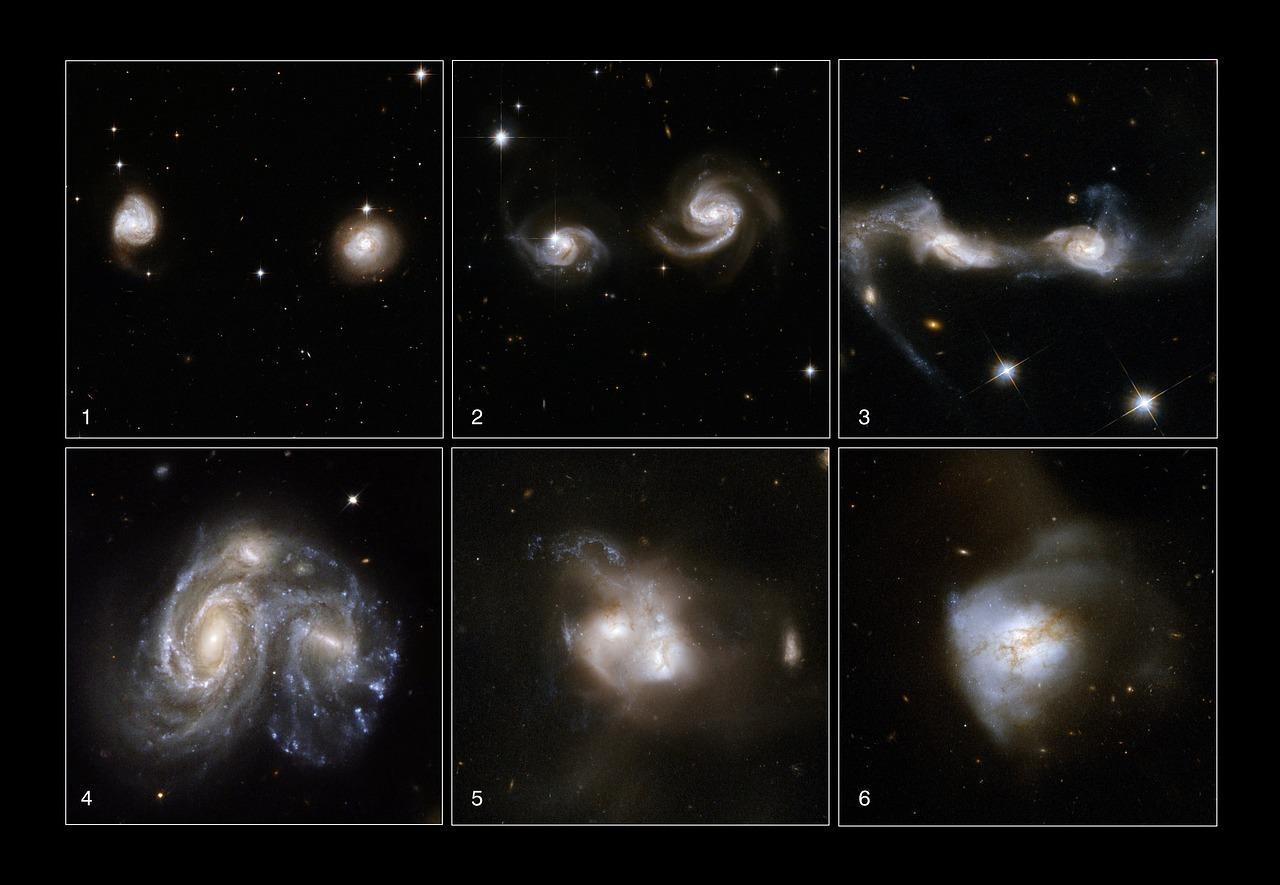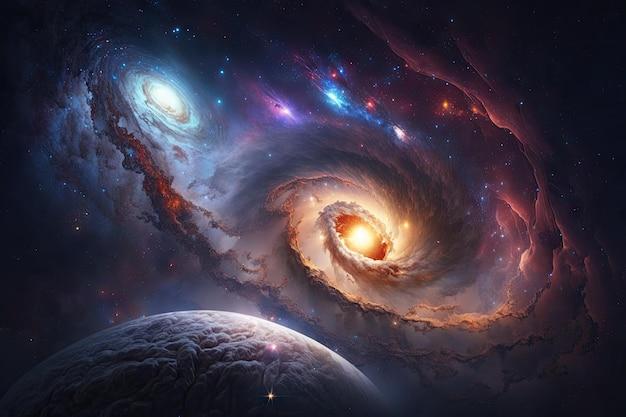Galaxies, those magnificent cosmic structures that awe us with their beauty and vastness, are an endless source of fascination for astronomers and enthusiasts alike. Among these celestial wonders, the Milky Way holds a special place as our very own home in the vastness of space. But have you ever wondered just how big our galaxy is in comparison to others?
In this blog post, we will delve into the dimensions and characteristics of the Milky Way, exploring its size in relation to other galaxies. We’ll also touch upon intriguing questions about the age of the universe, the number of galaxies it contains, and whether the Milky Way is considered large in the galactic realm. So, buckle up and prepare for a cosmic journey as we unravel the mysteries of our galactic neighborhood.
How Big Is Milky Way Compared To Other Galaxies
Have you ever wondered how the Milky Way stacks up against the other galaxies in the universe? Well, get ready to have your mind blown! In this stellar subsection, we’re going to delve into the astonishing dimensions of our very own Milky Way and compare it to its cosmic companions. So buckle up and prepare for a journey that will leave you starry-eyed!
The Milky Way: A Galactic Giant
Our beloved Milky Way is no small fry when it comes to size. Stretching an impressive 100,000 light-years in diameter, it’s a massive spiral galaxy that serves as home to billions of stars, including our very own Sun. Imagine a giant celestial pancake swirling in the vast expanse of space, and you’re beginning to grasp the immensity of the Milky Way.
A Clash of Titans: The Andromeda Galaxy
Now, let’s talk about our closest neighbor and cosmic rival: the Andromeda Galaxy. Brace yourself, because things are about to get even bigger! Measure for measure, the Andromeda Galaxy puts up a fierce competition against the Milky Way. With a whopping diameter of 220,000 light-years, it’s like the Milky Way on steroids. In fact, it’s so vast that if the two galaxies were to collide (which they’re predicted to do in about 4 billion years), it would be a cosmic spectacle like no other!
The Mammoth Elliptical Galaxies
But wait, hold your intergalactic horses, because there’s more to explore in the realm of gargantuan galaxies! Allow me to introduce you to the elliptical giants – Maffei 1 and IC 1101. These colossal cosmic structures make the Milky Way look like a tiny speck in comparison. Maffei 1, lurking just beyond our neighbor Andromeda, stretches an astounding 130,000 light-years in diameter. Meanwhile, IC 1101 takes size to a whole new level, dwarfing everything in its path with a diameter estimated at a mind-boggling 6 million light-years. That’s one big mama!
Beyond the Scale: The Observable Universe
Now, let’s zoom out, way, way out, to contemplate the scale of the observable universe. Brace yourself for another mind-expanding revelation! The observable universe is estimated to be a staggering 93 billion light-years in diameter. Yes, you read that right – billions! Compared to this unimaginable vastness, even the largest galaxies appear as mere atoms in a cosmic sea. It truly puts into perspective how small we are in the grand scheme of things.
Wrapping Up the Cosmic Comparison
So there you have it, fellow space enthusiasts! The Milky Way, with its impressive 100,000 light-year diameter, showcases its remarkable size. However, when it comes to sheer scale, it finds worthy adversaries in the Andromeda Galaxy, Maffei 1, and the behemoth IC 1101. And let’s not forget that all these giants are mere specks in the vast expanse of the observable universe. Remember, these mind-boggling dimensions are just a glimpse into the cosmic wonders that continue to awe and inspire us. Keep looking up and let your imagination soar among the stars!
Disclaimer: The measurements mentioned are estimates based on current scientific knowledge and may be subject to revisions as new discoveries are made.
FAQ: How Big Is the Milky Way Compared to Other Galaxies
In the vastness of space, galaxies come in all shapes and sizes. Among them, the Milky Way holds a special place in our hearts as it is our galactic home. But how does our beloved Milky Way compare to other galaxies? In this FAQ-style section, we will explore some fascinating questions about the size and characteristics of the Milky Way in comparison to its celestial neighbors. So, let’s embark on this cosmic journey and explore the wonders of our galaxy!
How Large is the Milky Way Compared to Other Galaxies
Ah, the age-old question: “Size matters, but how big is the Milky Way?” Well, prepare to have your cosmic socks knocked off! The Milky Way is a behemoth, spanning an immense 100,000 light-years from end to end. Imagine trying to drive from one side to the other without hitting interstellar traffic!
Which Is the Most Beautiful Galaxy
Aesthetics are subjective, my friend, but one popular contender for the title of “the most beautiful galaxy” is the aptly named “Whirlpool Galaxy” (M51). With its majestic spiral arms adorned by intricate patterns of dust and gas, it’s a true cosmic masterpiece. Picture it as a heavenly canvas painted by the universe itself.
How Old is the Universe
Prepare to have your mind cosmically blown! The universe, my friend, is a venerable 13.8 billion years old. That’s more candles on a cosmic birthday cake than one can even fathom. But hey, it’s looking pretty good for its age, don’t you think?
How Old is Our Galaxy
Drum roll, please! The Milky Way clocked in at a respectable age of around 13.6 billion years. Just a cosmic hair younger than the universe itself, our galaxy has been swirling and twirling through space for quite a while. Imagine the stories it could tell if it could talk!
Is the Milky Way Considered a Large Galaxy
Are you ready for some astronomical perspective? The Milky Way, my friend, is actually considered a medium-sized galaxy. It may not be the biggest fish in the cosmic pond, but it certainly knows how to rock that spiral shape with pride!
Is There Anything Bigger Than the Universe
Hold onto your rockets, because we’re about to warp your mind! As mind-boggling as it may sound, the universe is the biggest show in town. Nothing can outshine its vastness. So, sit back, relax, and enjoy the cosmic spectacle that unfolds before your awe-struck eyes.
Is the Milky Way Smaller Than Most Galaxies
While it’s true that some cosmic giants out there make the Milky Way look like a mere speck of stardust, our galaxy still holds its own. When it comes to size, it’s in the cosmic middle ground. So, don’t underestimate the power of our magnificent Milky Way!
How Many Galaxies Are in Space
Let’s dive into the numbers game! Brace yourself, my friend, because there are roughly 2 trillion galaxies in the observable universe. That’s right – billions upon billions of galaxies, each containing countless stars and mysteries waiting to be unraveled. Talk about a crowded cosmic neighborhood!
How Old is Space
Prepare to have your conceptual socks knocked off! Space, my friend, is as old as time itself. You see, the fabric of space and time came into existence with the Big Bang a mind-boggling 13.8 billion years ago. So, buckle up and enjoy the timeless journey through the cosmos.
Can You Live on a Galaxy
Well, while galaxies may be the homes of countless stars and marvels, they aren’t exactly real estate for us mere Earthlings. Galaxies are vast cosmic structures, and we’re tiny specks in the grand scheme of things. So, for now, let’s just admire their beauty from the cozy comforts of our home planet.
What is the Oldest Thing in the Universe
Get ready for a blast from the past – the oldest known object in the universe is an ancient star with the catchy name “HE 1523-0901.” This stellar relic was born a mere 300 million years after the Big Bang, making it nearly as old as the cosmos itself. Talk about a real-life time traveler!
What is the Biggest Known Galaxy in the Universe
Drum roll, please! If we’re talking about cosmic giants, the reigning champion is the heftily named “IC 1101.” It’s a real heavyweight, boasting a mind-boggling diameter of about 5.5 million light-years. That’s more than enough space to park a few hundred Milky Ways!
What Galaxy Do We Live In
Welcome to the neighborhood! We, dear Earthlings, call the Milky Way our home. This spiral beauty is where we set up camp in the vastness of cosmic real estate. So, next time you gaze up at the night sky, remember that you’re part of this fantastic galactic family.
What is the Biggest Thing in the Universe
Hold onto your space helmets, because this one’s a doozy! The biggest known structure in the universe is the mind-bendingly vast “Hercules-Corona Borealis Great Wall.” Stretching over a staggering 10 billion light-years, it puts any Earthly structure to shame. Maybe we should rethink our architects’ budgets?
Are We at the Center of the Universe
Well, I hate to burst the bubble of our cosmic egos, but the answer is a resounding no. The universe doesn’t play favorites or grant privileges based on celestial real estate. We, my friend, are just tiny specks floating around in the grand cosmic symphony.
Where is Earth in Our Galaxy
Hold on tight, because we’re off on a cosmic scavenger hunt! Earth, our pale blue dot, is located in the Orion Arm of the Milky Way. It’s like finding a needle in a celestial haystack, but hey, we call it home sweet home.
What is the Next Closest Galaxy
Time to meet our cosmic neighbors! The Andromeda Galaxy, also known as Messier 31, holds the title of being the closest major galaxy to the Milky Way. It’s a staggering 2.537 million light-years away – practically a cosmic hop, skip, and a jump!
What is the Most Powerful Thing in the Universe
Prepare to be cosmically amazed! The reigning champ in the cosmic powerlifting competition is the humble (or not so humble) black hole. With its mind-boggling gravitational pull, it can consume matter, energy, and even light itself. Talk about a one-way ticket to the cosmic recycling bin!
How Fast is the Milky Way Moving Through Space
Get ready for a galactic joyride! The Milky Way is no couch potato – it’s hurtling through space at a dizzying speed of roughly 1.3 million miles per hour. That’s fast enough to make you spill your cosmic latte if you’re not holding on tight!
And there you have it, fellow cosmic adventurers – a journey through the wonders of our galaxy and its place amidst the cosmic tapestry of the universe. From its colossal size to its mesmerizing beauty, the Milky Way continues to captivate our imaginations. So, let’s gaze at the stars, ponder the mysteries of the cosmos, and always remember that in this vast universe, we’re all cosmic companions on this wild, extraordinary ride.

